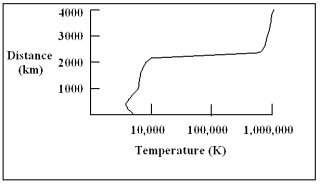B) False
Correct Answer

verified
Correct Answer
verified
Short Answer
A(n) ____________________ is a subatomic particle produced in nuclear fusion that can travel through the sun and escape to space without interacting with any particles in the sun.
Correct Answer

verified
Correct Answer
verified
True/False
Sunspots are hotter than the photosphere.
B) False
Correct Answer

verified
Correct Answer
verified
Multiple Choice
The ____ occurs when a rapidly rotating conductor is stirred by convection to produce a magnetic field.
A) dynamo effect
B) Zeeman effect
C) Babcock effect
D) proton-proton chain
E) aurora
G) C) and D)
Correct Answer

verified
Correct Answer
verified
Multiple Choice
The proton-proton chain
A) combines two hydrogen nuclei to produce a single helium nucleus and energy.
B) splits a helium nucleus to produce 4 hydrogen nuclei and energy.
C) is the mechanism that increases the temperature between the photosphere and corona of the sun.
D) is the interactions between protons in Earth's atmosphere that produces auroras.
E) produces energy in the core of the sun in the form of gamma rays, positrons, and neutrinos.
G) D) and E)
Correct Answer

verified
Correct Answer
verified
Short Answer
The ____________________ of the sun is composed of ionized gas and produces a continuous spectrum with a superimposed emission spectrum.
Correct Answer

verified
Correct Answer
verified
True/False
Solar flares have no known effect on Earth.
B) False
Correct Answer

verified
Correct Answer
verified
Multiple Choice
A filtergram is a photograph of the sun's surface made
A) in a band of wavelengths in the infrared.
B) in a band of wavelengths in the ultraviolet.
C) using the Zeeman effect.
D) with only those photons emitted in a specific spectral line.
E) none of the above.
G) B) and C)
Correct Answer

verified
Correct Answer
verified
Multiple Choice
The sun has a continuous visual spectrum with dark absorption lines. The continuous spectrum is produced by the ____________ layer while the dark absorption lines are produced by ____________layers.
A) inner chromosphere; outer photosphere
B) inner photosphere; outer chromosphere
C) inner chromosphere; outer corona
D) inner corona, outer chromosphere
F) C) and D)
Correct Answer

verified
Correct Answer
verified
Multiple Choice
The sun's magnetic field is evident in the looped shapes of
A) solar flares.
B) sunspots.
C) the corona.
D) granules.
E) prominences.
G) C) and D)
Correct Answer

verified
Correct Answer
verified
Multiple Choice
Diagram 7-1  -Diagram 7-1 shows a plot of the temperature of the sun as a function of distance above the bottom of the photosphere. What is the temperature of the sun at a distance of 2,000 km?
-Diagram 7-1 shows a plot of the temperature of the sun as a function of distance above the bottom of the photosphere. What is the temperature of the sun at a distance of 2,000 km?
A) 500 K
B) 900 K
C) 5,000 K
D) 9,000 K
E) 100,000 K
G) B) and D)
Correct Answer

verified
Correct Answer
verified
Multiple Choice
What is the explanation for the pattern of granulation seen on the visible surface of the sun?
A) The granules form the base of a circulation pattern that extends from the photosphere to the outer corona.
B) The granules are regions of nuclear energy generation in the sun's photosphere.
C) Each granule contains a strong magnetic field, which compresses and heats the gas underneath it.
D) The granules are the tops of hot gas that have risen from the sun's convective zone.
F) B) and D)
Correct Answer

verified
Correct Answer
verified
Multiple Choice
Sunspots are known to be magnetic phenomena because
A) Doppler shifts in spectral lines are observed.
B) the Zeeman effect is observed in sunspots.
C) collisional broadening is observed in spectral lines.
D) infrared observations indicate that the sunspots are cooler than their surroundings.
E) observations during eclipses reveal a very extensive photosphere.
G) C) and E)
Correct Answer

verified
Correct Answer
verified
Short Answer
The dynamo effect is believed to produce the ____________________ of the sun.
Correct Answer

verified
Correct Answer
verified
Multiple Choice
The United States consumes 2.5*1019 J of energy each year. A typical solar flare releases 5.0*1024 J of energy. How many years could we run the United States on the energy released by this solar flare if all of the released energy could be used?
A) 5*10-6 years
B) 200,000 years
C) 1.25*1044 years
D) about 12 years
E) 500 years
G) A) and C)
Correct Answer

verified
Correct Answer
verified
True/False
Initially, scientists detected lower than the expected number of neutrinos from the sun.
B) False
Correct Answer

verified
Correct Answer
verified
True/False
There is only one form of neutrino.
B) False
Correct Answer

verified
Correct Answer
verified
Multiple Choice
As the moon covers the solar disk during a solar eclipse, a flash spectrum of the sun's chromosphere can be recorded. This flash spectrum reveals an emission spectrum and provides information on the properties of the chromosphere. As the moon moves from the inner chromosphere to the outer chromosphere, the spectral lines present in the flash spectrum change. What is going on in the chromosphere that produces the changes in the flash spectrum? 
A) I & III
B) I & IV
C) II & III
D) II & IV
E) I
G) A) and C)
Correct Answer

verified
Correct Answer
verified
Not Answered
What evidence do we have that the chromosphere is hotter than the photosphere?
Correct Answer

verified
Correct Answer
verified
Multiple Choice
The rotation of the sun's photosphere is
A) fastest at the equator, slower at mid-latitudes, and slowest near the poles.
B) slowest at the equator, faster at mid-latitudes, and fastest near the poles.
C) fastest at the equator, slowest at mid-latitudes and the poles which travel at the same speed.
D) the same regardless of latitude.
F) A) and C)
Correct Answer

verified
Correct Answer
verified
Showing 21 - 40 of 101
Related Exams